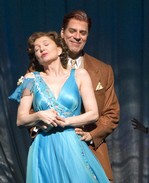SITE GUIDE
SEARCH
REVIEWS
REVIEW ARCHIVES
ADVERTISING AT CURTAINUP
FEATURES
NEWS
Etcetera and
Short Term Listings
LISTINGS
Broadway
Off-Broadway
NYC Restaurants
BOOKS and CDs
OTHER PLACES
Berkshires
London
California
New Jersey
DC
Connecticut
Philadelphia
Elsewhere
QUOTES
TKTS
PLAYWRIGHTS' ALBUMS
LETTERS TO EDITOR
FILM
LINKS
MISCELLANEOUS
Free Updates
Masthead
A CurtainUp Review
People in the Picture
By Elyse Sommer
|
Remember who you are When they step in and try to redo you Remember who you are 'Cause they're all gonna try to unjew you. —Krinksy and Pinker in the song that hammers home the musical's theme with two reprises. |

Donna Murphy & Christopher Innvar
(Photo: Joan Marcus) |
Manipulatively hokey and derivative The People In the Picture surely is. A ground breaking addition to the musical theater canon it isn't. Nor is it likely to make the top of the list of tourists looking for more glitzy, light-hearted entertainment. Yet it does have enough going for it to please Roundabout regulars and anyone hooked on nostalgic weepies — most notably Donna Murphy as a vibrant young Polish actress and as a sick and somewhat demented old woman in New York.
The flute and accordion players who first enter the stage immediately raise one's hopes of a new Fiddler on the Roof. The inclusion of a number about a dybbuk in the program's song list evokes visions of something to rival Tevye's surreal dream song. But librettist-lyricist Iris Rainer Dart is no Sholom Aleichem but a contemporary TV scriptwriter and novelist (the best selling Beaches became a flood of tears inducing film starring Bette Midler). So, don't expect a second coming of Fiddler.
By building her story around the star of a 1930s Warsaw based Jewish stage and film making company Ms. Dart did, however, open the door to flavoring the musical score with Klezmer's heart piercing sweetness and a nostalgic replay of the humor and intensity that was the hallmark of Yiddish theater. Her shift in narrative focus from a poor milkman in a turn of the century Russian village to the acting company concept also raised the possibility of tapping into yet another popular piece from that period, Ernst Lubitsch's 1942 comedy, To Be Or Not To Be. While more stageworthy than the 2008 non-musical play of the same name (review), The People in the Picture, also lacks that film's satiric spark.
Lubitsch, himself a Jewish refugee, gave his acting troupe's religion of self-absorbed theatricality which made their comically outwitting the Nazi more universal and pungently ironic. Dart's Warsaw Gang's distinctly Jewish identity dooms them to be victims and the show to being a tearjerker with a message. That message — to remember the Holocaust and its victims — gives The People In the Picture its second big anthem, "We Were Here." Granted, it's a message that bears repeating, if not allowed to be quite as treacly as it is here.
Donna Murphy deserves to be made an honorary Jew for keeping the overcooked sentimentality in check and for her adept flashes backwards and forwards between her Raisel days in Poland and her 1977 New York life as an ailing grandmother struggling to pass the torch of remembering to her granddaughter Jenny (Rachel Resheff). This puts her at odds with her daughter Red (Nicole Parker) who'd rather forget all the talk about the past for reasons that when finally fully revealed make for one of the show's most compelling, eye-dampening scenes. Actually that secret, is a subject rife with a moral dilemma worthy of a show of its own.
The way she switches ages, accents and moods with body language and minimal costume props adds up to a performance that makes you forget any doubts about casting someone less than 100% kosher in this role. Oh, and did I say that she has a genuine diva's voice and delivery and in one number ("Selective Memory") actually sings as both Raisel and Bubba without missing a beat. Yet even Murphy can't overcome the fact that the libretto is too sketchily constructed and characterized to avoid leaving one feeling let down, even if maneuvered into shedding a few tears.
Parker's character is so under developed that she often seems more like a by-stander than a major participant in this 3-generation saga. Her being a TV comedy writer and Murphy's Raisel making much of the importance of humor begs to be used to better develop what should make mother and daughter close, but doesn't.
Two other way too underdeveloped characters are the men in Raisel's life: Chaim Bradovsky (Christover Innvar), the handsome director who she hopes to follow to Hollywood and the Jewish homosexual Moishe Rosenwald (Alexander Gemignani) who marries her to give her unborn child a name. An unfortuante waste of two talented actors. The show does have its share of humor, most of it courtesy of the Warsaw Gang's comics, Yossie Pinsker and Avram Krinsky, zestfully performed Chip Zien and Lewis J. Stadlen respectively.
As for Mike Stoller and Artie Butler, they have strong songwriting credentials and their score is often quite good; so are Dart's lyrics, except when she permits them to get shamelessly syrupy. Ultimately, even the much reprised anthem song, "Remember Who You Are," Murphy and company's splendid singing and Paul Gemignani's expert musical direction never add up to real stick to the ear memorability.
Its shortcomings notwithstanding, The People in the Picture is beautifully staged within a huge gold leafed picture frame proscenium and an otherwise unfussy set by Riccardo Hernandez. Under Leonard Foglia's direction, the scenes from the past and present flow into each other with tremendous theatricality. Though not an obviously danceable show, Andy Blankenbuehler's musical staging uses traditional folk dances to excellent advantage, with an especially well choreographed scene at the top of the second act. Nicely done too are Ann Hould-Ward's costumes and James F. Ingall's lighting.
The torn corner of that main picture frame is a powerful visual symbol of what makes the story of the people in this picture worth remembering — as well as the all too many others whose familes were torn apart by a terrible chapter in modern history.
|
The People in the Picture Book & Lyrics by Iris Rainer Dart. Music by Mike Stoller and Artie Butler Directed by Leonard Foglia Cast: Donna Murphy (Bubbie), Alexander Gemignani (Moishe), Christopher Innvar (Chaim), Nicole Parker (Red), Rachel Resheff (Jenny), Hal Robinson (Doovie, Rabbi Velvel), Lewis J. Stadlen (Avram Krinsky), Chip Zien (Yoshie Pinsker). Musical Direction: Paul Gemignani Orchestrations: Michael Starobin Musical Staging: Andy Blankenbuehler Sets: Riccardo Hernandez Costumes: Ann Hould-Ward Lights: James F. Ingalls Sound: Dan Moses Schreier Projections: Elaine J. McCarthy Hair & Wigs: Paul Huntley Make-Up: Angelina Avallone Stage Manager: Peter Wolk Running Time: 21/2 hours including one intermission Roundabout at Studio 54254 West 54th Street From 4/01/11; opening 4/28/11; closing 6/19/11 Tickets $37.00 - $122.00 Tuesday through Saturday evenings at 8:00PM with a Wednesday, Saturday and Sunday matinee at 2:00PM. Reviewed by Elyse Sommer at 4/27 press matinee |
|
Musical Numbers (* Music by Mike Stoller. . .
** Music by Artie Butler. . . ! Music & Lyrics by Mark Warshavsky, 1845-1907
| |
Act One
|
Act Two
|
|
REVIEW FEEDBACK Highlight one of the responses below and click "copy" or"CTRL+C"
Paste the highlighted text into the subject line (CTRL+ V): Feel free to add detailed comments in the body of the email. . .also the names and emails of any friends to whom you'd like us to forward a copy of this review. Visit Curtainup's Blog Annex For a feed to reviews and features as they are posted add http://curtainupnewlinks.blogspot.com to your reader Curtainup at Facebook . . . Curtainup at Twitter Subscribe to our FREE email updates: E-mail: esommer@curtainup.comesommer@curtainup.com put SUBSCRIBE CURTAINUP EMAIL UPDATE in the subject line and your full name and email address in the body of the message. If you can spare a minute, tell us how you came to CurtainUp and from what part of the country. |

Slings & Arrows-the complete set
You don't have to be a Shakespeare aficionado to love all 21 episodes of this hilarious and moving Canadian TV series about a fictional Shakespeare Company






